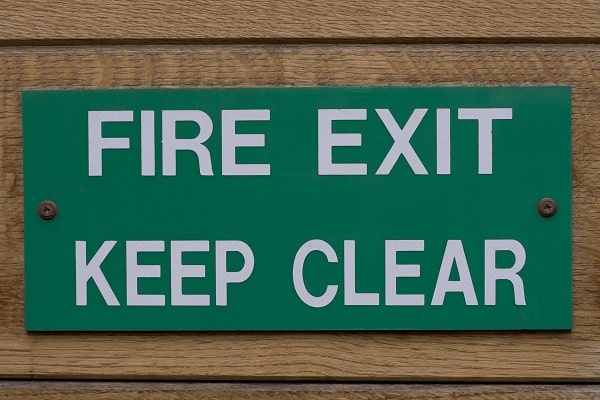The
National Fire Protection Association (NFPA) publishes NFPA 101, the Life Safety Code, to provide the minimum requirements for the design, operation and maintenance of buildings and structures for life safety from fire and similar emergencies. Many states have adopted NFPA 101 as a regulatory requirement, using it as a basis for evaluating the premises liability exposures for a building or structure.

The primary goal of the Life Safety Code is to provide an environment designed to protect the occupants in the event of an emergency. The most recent updates to the
2018 edition of the Life Safety Code address how to limit the dangers caused by fire, smoke, heat and toxic fumes through proper building design and construction. The 2018 version also was expanded to cover hazardous materials emergencies, injuries from falls and emergency communications.
NFPA 101: Building Fire Safety Checklist

Advances in building technology mean today, there are fewer reasons for a modern, properly-designed building to catch fire and cause loss of life. However, this doesn’t mean accidental fires no longer occur. In fact, according to research from the NFPA, between 2011 and 2015 there were nearly
38,000 fires reported at industrial or manufacturing properties alone. Likewise, between 2010 and 2014 an estimated
7,410 structure fires took place in eating and drinking establishments. These fires resulted not only in millions of dollars of property damage, but also in civilian injuries and even deaths.
With May being
Building Safety Month, there’s no time like the present to review the Life Safety Code to help minimize the danger to life a fire can cause. Some of the fundamental requirements and fire safety tips described in NFPA 101 that apply to all buildings and structures include:
NFPA 101 Egress Requirements
A means of egress is “a continuous and unobstructed way of travel from any point in a building or a structure to a public way consisting of three separate and distinct points:
1) The exit access
2) The exit
3) The exit discharge
General egress requirements include having
safe walkways that are slip resistant, kept clean and well-lit, keeping exits unobstructed from furnishings, decorations and other objects, doors with locks and hardware installed to permit free escape, and clearly visible evacuation signs.

Fire protection features
NFPA 101 describes the basic requirements for structural features of fire protection. Both new and existing buildings should meet the minimum construction requirements defined for the occupancy, and where required by occupancy chapters, buildings must be divided into compartments using fire barriers. Additionally, in multiple-story buildings, floors should be constructed as smoke barriers and vertical openings protected with fire barriers unless specifically exempt. Additional protection like automatic sprinklers should be provided in areas that pose higher degrees of fire hazard then the general occupancy.
These requirements help limit the spread of fire and smoke throughout the building, protect exit access and ensure the integrity of the building is maintained for the time needed for all occupants to evacuate safely.
Building services and fire protection equipment
The Life Safety Code provides general requirements regarding building services such as gas equipment and piping, electrical wiring, elevators and escalators, heating, air conditioning, ventilating, commercial cooking equipment and more are installed and operated in accordance with safe practices. Additionally, the code defines general provisions for the installation and maintenance of smoke control systems, fire detection, alarm and communication systems, automatic sprinklers and other extinguishing equipment.
Interior finishes, contents and furnishings
Contents and furnishings can easily increase the overall fire hazards in a building or structure when they can ignite and spread fire rapidly, or generate smoke and toxic gases. When it comes to the wall, ceiling and interior floor finishes in buildings, the NFPA 101 requires all materials are evaluated for speed of flame spread and smoke generation, like draperies, upholstered furniture and mattresses. It also prohibits the use of higher hazard materials in certain areas of the buildings, like the means of egress.
Modifications for special structures
Additional fire safety requirements have been established by the Life Safety Code for special structures like tents, towers, piers, water-surrounded, underground, windowless or open structures. Likewise, high-rise buildings greater than 75 feet in height must be protected by an approved, supervised automatic sprinkler system, Class I standpipe system, fire alarm system, emergency lighting and standby power system, and contain an emergency command center.

Loss Control Services from AmTrust Financial
AmTrust’s
Loss Control Department specializes in risk management solutions designed to fit your operation. We can help your small business assess the conditions, practices and processes of the workplace to help identify hazards, recommending strategies to help reduce, control or eliminate accidents and losses. We are dedicated to providing the right
resources to create the most effective loss control program for your specific needs. For more information, please
contact us today.
This material is for informational purposes only and is not legal or business advice. Neither AmTrust Financial Services, Inc. nor any of its subsidiaries or affiliates represents or warrants that the information contained herein is appropriate or suitable for any specific business or legal purpose. Readers seeking resolution of specific questions should consult their business and/or legal advisors. Coverages may vary by location. Contact your local RSM for more information.